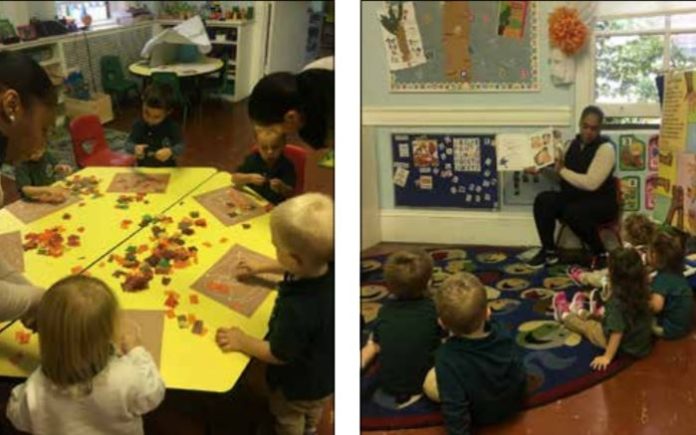By Lisa Gilbert, Principal, St. Peter Academy
“Clean up, clean up, everybody do their share. Clean up, clean up, everybody, everywhere.” The well-known children’s song played softly in the background as Ms. Carmen’s two and three-year-old students went busily about their classroom picking up the colorful red, blue, green, yellow, and purple foam blocks they had been playing with a few minutes earlier. A pig-tailed girl brought her block to me, and as she held it up she proudly declared, “Green!” She is two.
Earlier in the morning, the group of twelve young scholars sat on the carpet in a circle intently watching and listening to a clip on their music teachers’ iPad. “A person who plays the piano is a pianist,” says Ms. Migle. “Who here is going to be a pianist?” The eager toddlers answer in unison, “Me,” they exclaim. “Now, all my pianists, listen to this song,” suggests Ms. Migli. And with that, they listen to an upbeat rendition of “Twinkle, Twinkle Little Star.” Within moments, the children can’t help themselves and they start to sing along to the familiar tune, abandoning all attempts at passive listening.
So, the morning goes in the Toddler Blue (blue for the color on the walls) classroom at St. Peter Academy in South Boston. The lively little ones rotate from table to carpet to outside and back around in a constant and predictable cycle of movement and play-based learning. Ms. Carmen Pepin, their lead teacher, is a seasoned professional. Her tenure with St. Peter Academy began over a year ago and she works tirelessly to be a nurturing and consistent presence for students. Stealing Ms. Carmen away from her flock for a brief commentary, I applaud her for the children’s uncanny ability to follow directions. She modestly states, “I try.” Indeed, not only are her students aware of her expectations, but they are able to meet them, as well. Their day is carefully constructed to meet their developmental needs. Lesson planning is intentionally designed with age appropriate activities.
Ms. Carmen leaves my side to gather the children at circle for Literacy. “Now my friends, take a seat on the red line.” Without hesitation, twelve tiny toddlers take their places on the carpet. “Remember when we read this story yesterday?”, asks Ms. Carmen as she holds up a book at eye-level for the students to see. “Who remembers what it’s about?”, she asks. Several students offer answers to her questions. The others look on eagerly waiting for the story to be read. Ms. Carmen reads with a measured, deliberate cadence, making sure to point to various objects in the pictures. She knows that good readers develop from being exposed to quality children’s literature with rich vocabulary. She pauses to illicit student feedback and to comment on the storyline, helping these pre-emergent readers to make important connections with text. When the story is finished, she allows for some discussion to sum it all up, followed by a cute little musical number entitled, “Shake Your Sillies Out.” The students are amused by the movements suggested in the song, as they follow along. “Jump your jaggles, shake your sillies, yawn your yawnies…” Each new command uses a different body part encouraging a total physical response.
Soon, tired two and three-year-old children will eat their lunch and hunker down for an afternoon nap. Ms. Carmen and her assistants will watch over them as an instrumental version of the Beatles “Let It Be” lulls them to sleep. Sleep well, little ones. Before too long, they’ll wake up and start all over again.













